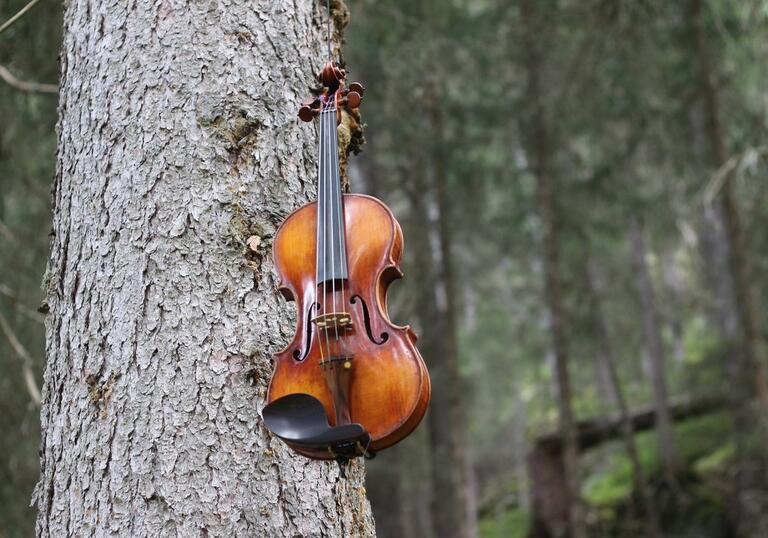Unlike traditional concerts, this experience actively encourages you to explore the lush greenery, tinkling water, concrete, steel and glass of the Conservatory while you listen to music. Wander amid the 1,500 plant species and discover work by some of the most exciting contemporary classical composers and performers, all of whom have been reflecting on the climate crisis.
Equally divergent from a ‘normal’ concert is that many works use unconventional instruments, from single-use plastic to harps played by the wind and triangles made from steel bars usually found in reinforced concrete.
In many ways, then, this has all the hallmarks you’d expect from a Nonclassical show. The promoter, record label and events producer has a well-deserved reputation for defying convention and sharing innovative music in non-traditional performance spaces.
Among the array of new works will be the first performance of sculptor and musician Marcus Vergette’s Tintinnabulation, which uses the sound of bells he made by hand, accompanied by piano, double bass and bird calls.
The work explores the idea of a world with birds and a world without them. Listen to the sounds of bells on wheels and smaller, handheld bells as you wander around the Conservatory and discover changing experiences to the sound as you move in relation to them. ‘Your movement alters the sound because bells create a complex resonance that changes according to your location as opposed to stringed instruments such as the piano and the bass,’ he says. ‘It’s like a rainbow – everyone can see it, but it’s different for each person.’
Vergette is particularly interested in the resonance of bells and the things that happen while they’re ringing. ‘Different frequencies appear to blossom out of the reverberation. And that’s what I want to play with,’ he says. ‘Bells create a very unusual type of soundwave. It’s like a giant vibrating jelly because the whole cone reverberates. When you play a string, it’s just a little sound through space and time. Whereas when you get caught inside a bell and the frequencies it creates, some are hardly audible, but you still feel them.’
Tintinnabulation was made during the first lockdown, when all the bells he’d created were on his farm. ‘I decided to record them all together, as it was unlikely that so many of them would ever be together again,’ he says. ‘Tintinnabulation is composed using studio recordings of my bells and recordings of them outside, with birdsong in the background. The composition utilises the interaction of the bells and the birdsong for its harmonic and melodic content.’
There will also be three tracks by Quinta (the stage name for London-based multi-instrumentalist Katherine Mann). They were written on Aeolian harps she made by hand while on a residency on the Greek island of Euboea, where a strong summer wind called the Meltemi blows every year. These instruments are ‘played’ by the wind and are named after the Greek god of the wind, Aeolus.
‘My album combines acoustic instrumentation (in the form of strings) and electronics, improvisation and composed material,’ she says. ‘The aim was to create music that seemed organically generated, that didn’t seem overburdened by human intervention. I hoped it would sound as if it had sprung from the air, trees and mountains. I realised early on that I couldn’t force the Aeolian harps to sing: I had to wait for a collaboration with nature. I wanted to create music that reflected this relationship.’
We hear three tracks today: Meltemia – named for the summer winds that were the context for her harps’ first outing; Dasos, which is Greek for ‘woodland’ and features rich, rumbling double bass underneath the bird- and insect-like textures of the harps’ upper strings; and Chloris, named after the mythical character abducted by the god of the west wind, Zephyrus.
‘For me, any performance with the harps demands a unique environment, as their sound is quite otherworldly and ethereal,’ says Quinta. ‘I’ve only shown them once before – on an Athens rooftop at sunset. The setting of the Barbican Conservatory and the theme of climate seem an ideal context for another sharing.’
Also being performed is Nonclassical founder and composer Gabriel Prokofiev’s Tracing Contours, Lines & Planes, which is inspired by the architecture of the Barbican itself. The London Triangle Orchestra will perform it on specially constructed instruments made from rebar, the steel rods used to reinforce concrete.
Composer and sound artist Claudia Molitor employs single-use plastic to create sounds and effects in her piano work Polymer Hauntings, a requiem to fossil fuels and one of their most prevalent, insidious products. Yshani Perinpanayagam and Katherine Tinker will perform on a plastic sheeting-covered piano, with single-use plastic bags and containers placed inside according to the composer’s directions. ‘I hope Polymer Hauntings will become unperformable in the very near future due to its need for everyday, single-use plastic,’ Molitor says. ‘In this sense, I hope it is its own requiem.’
Carola Bauckholt has written several works which feature birdsong. Today we’ll hear Doppelbelichtung (the German word for ‘double exposure’), which deploys violins around the Conservatory, some of which have small speakers inside them from which electronic bird song emanates. Live violinists perform in dialogue with electronic reproductions, reflecting the sounds of the wild. ‘Today’s technology allows us closely to examine bird calls as though under a microscope, enabling us to create intriguing musical fusions,’ Bauckholt says.
Abstruckt create percussion from flower pots, teacups and other random objects to perform works by Andy Akiho, David Lang and Steve Reich. And in the final show, 16 lamps from Mátyás Wettl’s Nocturne will cast a warm glow over the evening’s music-making.
© James Drury

